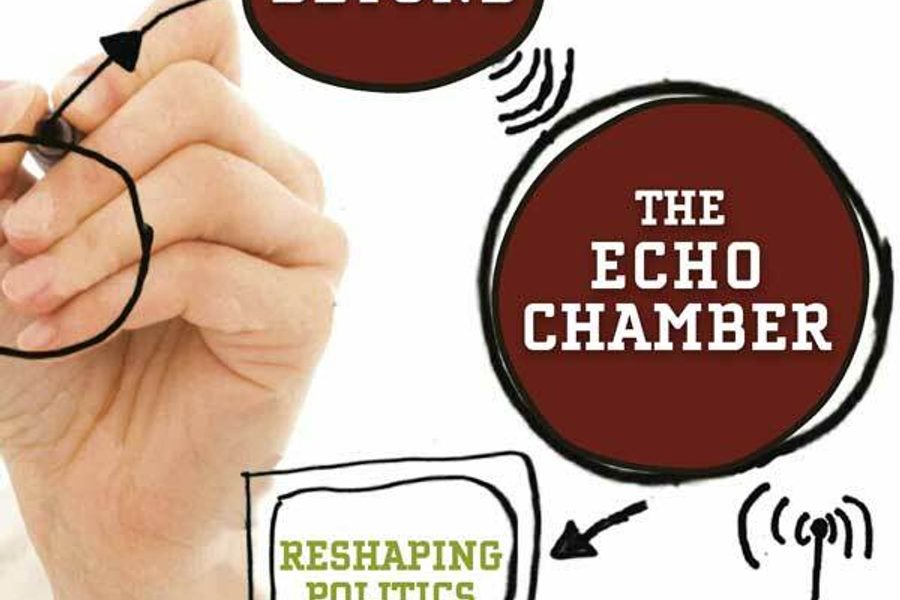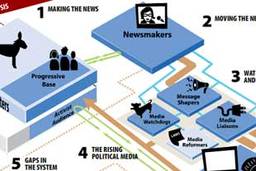Beyond Pale, Male and Stale
Why ‘legacy’ progressive media must reinvent themselves to remain relevant.
Jessica Clark and Tracy Van Slyke

To reach out to and sustain relationships with so-called “minority users,” progressive media makers need to move beyond their core white audiences (pale), reach out to women and queer communities (male), and stop being so serious all the time (that is, wonkish, humorless, and stale).
These are not matters of political correctness — they are matters of political clout, democratic representation, and sustainability. Between 2004 and 2008, online political media designed to inform and mobilize these communities has largely been produced by interlinked groups of networked outlets: the black blogosphere, with an active subset known as the “Afrospear”; the brown blogosphere, comprised of a varied group of contributors concerned with issues of immigration and prejudice; and the feminist blogosphere, which provides more accessible outlets for a younger generation of women. A number of sites and projects also target progressive youth and less traditional progressive activists via humor, culture, and art.
Second-wave feminists have had their print mainstays, most notably Ms. magazine, launched in 1971, and Off Our Backs, published since 1970, supplemented by an evolving and often shortlived selection of movement newspapers, magazines, and ’zines.
In more recent years, edgier feminist magazines have emerged, ranging from Bitch magazine, which takes on pop culture from a feminist point of view, to Bust magazine, which incorporates pop culture such as fashion layouts and celebrity interviews, to Hip Mama, which addresses motherhood with a political and humorous edge. A similar range of publications — from radical and scrappy to commercial and glossy — address politics, lifestyle, culture, art, and trends related to the concerns of GLBTQQ audiences and others challenging traditional gender roles.
In cities across the country, “ethnic” media are also increasingly popular, informing different communities of color and immigrants. Many of these take the form of local newspapers that both tie together communities and reach out into international diasporas organized around shared language or culture. In addition to commercial publications such as Jet and Ebony, over the past few years new online ethnic media outlets such as The Root, a Washingtonpost/Newsweek Interactive endeavor focusing on African Americans, have also sprung up. But these publications rarely identify their political stance as “progressive.”
While legacy progressive media makers are often far better than the establishment media in acknowledging issues of race and gender inequity, many observers still feel that that the issues and perspectives critical to these communities are too often “ghettoized” by these outlets. Progressive media’s reporting and analysis will often focus on national (sometimes local) politics, elections, scandals, economic issues, and corruption without looking through the lens of minority communities or regularly reporting on the issues facing them.
Why is this so important to do? Let’s get down to brass tacks.
Diversity=the future
In addition to championing core civil rights values, such communities have been noted as major swing voters in the 2004 and 2008 elections. According to an April 2009 report from the Pew Research Center, “The electorate in last year’s presidential election was the most racially and ethnically diverse in U. S. history, with nearly one-in-four votes cast by non-whites. … The nation’s three biggest minority groups — blacks, Hispanics and Asians — each accounted for unprecedented shares of the presidential vote in 2008.”
Women have also wielded significant political clout in recent elections — especially single women, who skew younger and less financially secure. “Unmarried women played a pivotal role in making this history and in changing this nation,” according to Greenberg Quinlan Rosner Research. “They delivered a stunning 70 to 29 percent margin to Barack Obama and delivered similarly strong margins in races for Congress and the U.S. Senate.”
Millennials comprise another swing bloc. “In 2008, 18 – 29 year olds, now all members of the Millennial generation, voted Democratic by a stunning 66 – 32 margin,” wrote Ruy Teixeira, a political demographer and senior fellow at both the Center for American Progress and the Century Foundation. Obama’s support among this age group extended across racial barriers,” he notes. “So much for the idea there is nothing distinctly progressive about today’s Millennials,” writes Teixeira in a related report, “Generation We and the 2008 Election.”
But it’s not good enough to pay attention to these communities when the election season swings into high gear, or just after a national disaster such as Hurricane Katrina. If progressive media organizations want to inform and activate these communities and ultimately move them to more liberal or progressive stances, producers must provide regular and frequent reporting that interests them, appeals to them, and is about them. And frankly, progressives need to be much more conscious that while they may rest on their laurels because they believe in social justice and equality, their actions sometimes do not match their rhetoric.
“The demographics of this country are changing dramatically,” says Larry Irving, a former assistant secretary for communications and information in the Clinton administration. “Tech is changing dramatically. The willingness to hear progressive media is increasing dramatically. There is a certain window of time to make something long lasting. Progressives like talking openness, but they like being a club.”
Irving, who coined the now-popular phrase “the digital divide,” contends,
There is anti-democratic smugness in a democratic community. The reason the term ‘media elite’ catches hold with people is because that’s how they come off. … The biggest challenge to progressive media: being honest, intellectually embracing and not walling ourselves off from the millions of people who worry that progressive elites look down on them.
This perspective has business repercussions as well. Many in the progressive media, especially within the legacy media, find themselves with an audience of white, aging males. (One of us— Tracy — has often joked that some progressive magazines should start targeting nursing homes for advertising.) Looking to the future, ethnic communities and young women are huge potential new audiences. If harnessed and communicated with correctly, they could become future sources of income, providing sources for advertising dollars, donations, and subscriptions. What’s more, it should be an honor and challenge for the progressive media as a whole to be more inclusive and representative of the complicated, messy, and wonderful melting pot known as America.
In his 2006 article “A Party in Search of a Notion,” Michael Tomasky, then editor of the American Prospect, called for the Democrats to turn their back on “the million-little-pieces, interest- group approach to politics,” and adopt the philosophy “that citizens should be called upon to look beyond their own self-interest and work for a greater common interest.” In supporting this argument — which, to be fair, does credit several civil rights victories to those who organized around their own interests — Tomasky cited an honor roll of male politicians, philosophers, journalists, and even bloggers. In doing so he demonstrated a stifling lack of diversity in a widely touted cover piece suggesting that the politics of diversity be scuttled.
‘We know we can do better’
The progressive press could learn from the historic failures of the black press. Kevin Weston, director of new media and youth communications at New America Media, a network of more than 700 ethnic outlets that also produces original content across several platforms, reflects on how the black press missed the boat in expanding their audience:
In the eighties, the black press was at its height in terms of numbers of papers and financial stability, but all of the black establishment ignored hip-hop. Ebony didn’t put a rapper on its cover until the late ’90s. So all of those journalists that would have started in the black press got started in the hip-hop press. Fast-forward to 2009. The black press is still working: it’s niche, hyperlocal, and [has] long-time relationships with big advertisers. But they missed out on a whole generation of journalists.
The same could be said for the legacy progressive outlets, and even the most visible members of the blogosphere. Their inability to reach out to a diverse base of contributors and readers has left a gap in political communication, alienating audiences that might otherwise be inclined to identify as progressives.
Steve Katz, vice president of strategy and development at Mother Jones, echoed Weston’s sentiment in 2005. “We’re trying to redefine who we are to reach the audience of the 21st century,” he said. “Progressive media is to the progressive audience as classic rock is to the radio audience. We know we can do better and we know people are looking for good journalism and a progressive point of view.”
To fill the void, there has been a rise in online communities that have provided compelling and important services for their users. While these online communities often have smaller audience numbers than the more well-known progressive outlets, their function is no less important. These ever-growing media organizations reach targeted communities through a broad set of techniques: reporting and analysis, organizing and action, satire and personal essay, media critique, blogging, and commentary. They provide a safe space for assembling their own choirs: discussing, debating, and assembling around shared concerns. They also provide a critique of both establishment and progressive media, movements, and organizations. Last but not least, they dive more deeply into issues affecting their users.
What often sets these outlets apart is how these producers, sites, and communities reach out and activate their audiences. Their expertise lies in their personal experience, background, and passion, which are reflected in the tone they adopt to communicate with their users — a tone that appeals because it represents an authentic and accessible voice, one that relates a shared identity and experience.
Nezua, one of the most prolific and popular bloggers in the brown blogosphere and founder of the blog The Unapologetic Mexican, points out the schism between the “white” media and the identity-based media. “We’re talking about our lives, our families, how our people came to this nation, thinking about our people still in the cross-hairs, seeing hate crimes rise against people like us. We’re not coming from a detached, distant, theoretical place.”
Developing an accessible voice is key for any media organization as it balances the cool and measured journalistic or academic approach with the more personal tone that the new media landscape demands. This is also where going beyond “stale” comes in. Alternative and new journalism pioneers — as well as comedians and satirists — set the stage for the rise of Rachel Maddow, Jon Stewart, and Stephen Colbert.
Similar approaches are echoed in the more personal style advanced by bloggers, and the rich universe of online humor and culture sites. All of these suggest that a better approach to framing and communicating critical perspectives might lie not in elitist language, as Irving suggests, but in finding more appealing ways to deliver the news. Humor and a willingness to cover and feature pop culture – including sports, music (and while we appreciate Pete Seeger, not his kind of music), television, film, and the trends that inform people’s everyday lives – are key ingredients for high-impact progressive media.
Copyright © 2010 by Jessica Clark and Tracy Van Slyke. This excerpt originally appeared in Beyond the Echo Chamber: Reshaping Politics Through Networked Progressive Media, published by The New Press. Reprinted here with permission.
Tracy Van Slyke, a former publisher of In These Times, is project director of The Media Consortium and co-editor of buildtheecho.net. Clark and Van Slyke are the co-authors of Beyond the Echo Chamber: Reshaping Politics Through Networked Progressive Media (2010, New Press)





